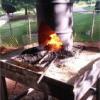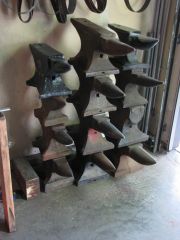-
Posts
1,602 -
Joined
-
Last visited
Content Type
Profiles
Forums
Articles
Gallery
Downloads
Events
Everything posted by Nobody Special
-

Just how much for a post vice these days?
Nobody Special replied to Hilt and Hammer Workshop's topic in Vises
Been watching CL for several months and hadn't seen one under 150. And those, broken. Then two weeks ago, found a guy with 15 of them, 40 each. Mine cleaned up nice with a little lube. -

My resignation to black smithing.
Nobody Special replied to kyotie11's topic in Blacksmithing, General Discussion
Don't go out of your way to provoke her, but ignore her and move on. She won't be the last person to complain. -
Welcome, Love the sun, nice effect with the rivets. It stems from different mythologies, but the sun cross is common in lots of parts of the world, including my favorite, the celtic cross. And your "bad English" is better than many native speakers. Thanks for sharing, I now have something new to add to my long wish-list of projects. :)
-

Question About Toxic Metals
Nobody Special replied to blitzs's topic in Zinc, galvanized, and coatings
Toxic metals? Zinc and zinc containing metals, like brass, some "bronzes", pennies made after 86. Lead, some steels with chromium in them. Some titanium alloys. The patina (green or blue stuff) can be toxic on copper, and it can be toxic if used to cook in.......and on and on.....although not as likely to run into cadmium and such.... Zinc's the really nasty one to watch for. Looks greyish, or whitish on steel, like on galvanized chainlink fence. Don't try to burn it off or melt it. Trust me, zinc poisoning sucks. Good ventilation is pretty much key anytime working with a furnace, forge, or metals.- 22 replies
-
- toxicmetalsmetal
- question
-
(and 2 more)
Tagged with:
-
Same thing happened to me the first time I tried smithing, using anthracite and managed to get the darn stuff lit. Fire management is a lot different with anthracite. It burns a lot hotter, and takes more air to keep going. (I still finished the knife. It's a terrible knife, not even much good as a letter opener, but I kept it anyways.) In my experience, no it doesn't really coke much. Try bitumous, it's more expensive, but you'll use a lot less coal and have a great deal more control over the fire, so it more than evens out. If you are still using the anthracite for awhile, don't keep your steel in as long, especially as it gets drawn down. And watch the fire. If you start seeing sparks or hearing the hissing sound, your steel's burning. I'm green next to most of these guys, but used anthracite a lot whilst working on the basics. Good luck and keep at it!
- 6 replies
-
- decarburization
- steel
-
(and 5 more)
Tagged with:
-
In georgia, paid 40 for a four and a half incher couple of weeks ago, not sure on the weight, fells like about 70, 80 lbs. I've seen similar go for around 200 here, but kept my eye out, and if I'd wanted more, the guy I got mine from had almost 10 in various condition for the same price.
-
Ditto what thomas powers said. Great site. Start with a "coffee can" furnace, even if bigger. Stay away from melting pennies or brass until you have a lot of experience unless you like getting sick as all get out. Find a mentor. Keep it simple, and read up so you don't blow something up in your face.
-
The bottom of a firepot doesn't burn out because the sweet spot (where melting temperatures can occur) of the fire occurs a few inches above the bottom. Since the coal uses an updraft to achieve decent forging temperatures, a lot of the heat is moved away from the bottom. Possibly the tray also helps act as a heat sink? It may eventually oxidize through, but this should take place much slower than with thinner metals, and shouldn't actually melt. I did lose a loose screen over the tuyere one time when it got tilted on end by my coal rake. At least that's what I think. Someone with more expertise can and probably will explain it better. My firepot is homemade refractory funneling in over a brake disc, and it takes a couple of years to slag away the portland cement in it so that I have to patch or replace it. In my experience from making casting furnaces, this refractory recipe would start to slag at anything much above 2300 degrees, or brass casting temperatures.
-
Please post when it's done, I'm in Marietta/work on Dobbins, and would love to see it.
-

Overview of metal casting for beginners
Nobody Special replied to dan_m's topic in Smelting, Melting, Foundry, and Casting
Nice tutorial. Ever try "lost foam" method of sand casting. Make your forms out of insulating foam and leave in/burn out during the pour. Makes a kind of pebbly finish, but worked well when I tried it. -

What do you guys think?
Nobody Special replied to 5starhobo (blake)'s topic in Anvils, Swage Blocks, and Mandrels
I think he's so overpriced I doubt he'll listen to reason. Have patience, something reasonable will turn up. -

Coal or coke?
Nobody Special replied to bourne101's topic in Solid Fuels: Coal, Coke, Charcoal, Wood, etc
How to light? Wad up some paper and put in bottom of forge. Light paper. Wait for it to take, then start blower and add a couple of handfuls of coal. Wait til that takes, add more coal. Takes some practice. -

Coal or coke?
Nobody Special replied to bourne101's topic in Solid Fuels: Coal, Coke, Charcoal, Wood, etc
Start your initial fire, and let the volatiles burn off, (you'll see plenty of smoke), then around the edge of the fire pile up some fresh coal and dampen with a waterer. (can with some holes poked in the bottom works well, on the end of some wire, even better). This keeps the smoke down while it cokes. Gradually push the coke into the fire and replace with fresh coal. Coke is .......fluffy? More porous, lighter than the coal. Different feel when you push it around. Also, you have to use bitumous coal to make coke. Heating coal/anthracite won't work, and is hard to keep lit and controlled. Coking also removes contaminates found in coal, such as phosphorus, which can weaken steel, although this was more important historically than it is now with blacksmith grade coal. Avoid breathing the smoke much unless you like black snot and coughing. A hood with a vent will work wonders, as well as dampening the coal while coking. -
My wife at church - "Honey, why are your shoes clicking when you walk?".........sigh.
-
My rune reading is rusty, "the gods guide me"? Lovely work, as always.
-
Well, you might want to consider changing the wheels if you try this. I've had entirely too much experience with hot metal/coals burning through rubber.
-
Could you post pictures of the sword? Might help with the feel/intent. Big difference in what ya put on a gladius to what ya put on say, a kris or a wa-tachi.
-
Dunno about these particular swords, but I've read that during certain periods it was common practice for Norse to sacrifice weapons, armor and other valuables, throwing in pits or peat bogs. The arms were sometimes intentionally damaged first. Also, while it's true that swords from the Norse period are forged, cast swords are not unheard of in other parts of the world, particularly the cast iron Chinese swords, starting during the Han dynasty. I don't like when people mix up the terms either.
-

Microstructure of burnt steel
Nobody Special replied to porkchop's topic in Heat Treating, general discussion
Like the post, like the pics. Maybe wrong, but thought steel ran from .5 to 2% carbon, wouldn't .326 be wrought iron? -
Welcome, Sam
-
If you're talking about while forming, put the rod in a vice and do your work near the vice surface to minimize wiggle. If you're talking about still loose after formed, you can do several things. Let it set on that tray on bottom, you could put a pin through the bottom for the candle to sit on, you could rough the inside edges or make burrs to grip the rod/candle. Or after shaping, close the circle a tiny bit more so that it is fractionally smaller than the candle and the candle should push into it a little. Of course the last one only works if you consistantly use the same size candles. You could also form it around a tapered rod so that the bottom curl is smaller, giving the candle something to sit on, then gradually opening to the desired size.
-
Most of the bronzes I cast began to melt at around 1800, 1900 degrees, say the lower end of yellow, and was poured around 2200-2300. As soft as silicone bronze is, I'd stay well into the orange range or lower for forging. Maybe about a light red/dull orange to be safe. I have much less experience hot forging with it than casting or cold work. Try some and see, just know that if it gets to bright yellow, you're probably in danger of starting to melt it. Nice thing about silicon bronze is it's much safer than some of the "bronzes" containing stuff like zinc. Also, it feels a lot softer than what you'd be used to in steel, even worked cold.
-
For the curl on top, when you shape it, form it around a cold rod the same diameter as the candle. Like when you make a socket by shaping it over a mandrel or a drift.
-
Drewed, I haven't had anything turning orange with iron jewelry, what kind of finish are you using? Simple design, nice work, gundog

